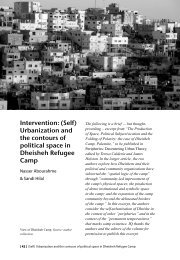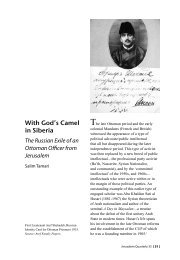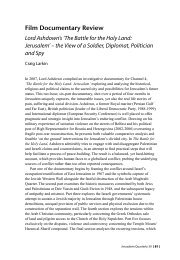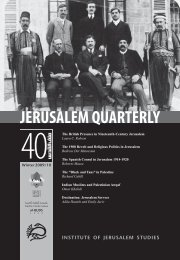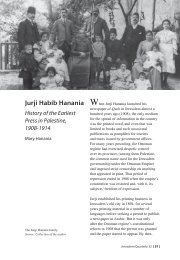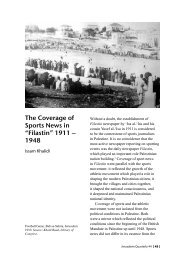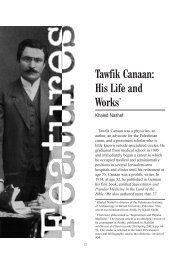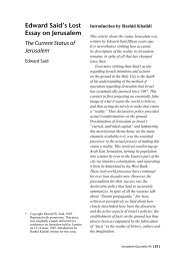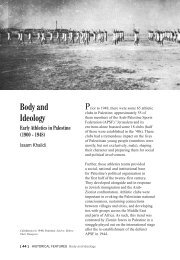PLUNDERING PALESTINE - Jerusalem Quarterly
PLUNDERING PALESTINE - Jerusalem Quarterly
PLUNDERING PALESTINE - Jerusalem Quarterly
Create successful ePaper yourself
Turn your PDF publications into a flip-book with our unique Google optimized e-Paper software.
Illegal Palestinian diggers usually work<br />
in crews of four to ten people. They<br />
excavate at night in order to evade<br />
land owners and the police. They dress<br />
in dark clothes and are usually armed<br />
with sophisticated equipment like metal<br />
detectors and tractors to dig deep into<br />
the ground, but also shovels, picks, axes,<br />
knifes and sifters. One or more members<br />
of the group act as observers to keep an<br />
A damaged shared tomb in Qarawa in the West eye out for any intruders, while the rest<br />
Bank. Photo credit: Adel Yahya/PACE<br />
dig. They usually do not search randomly,<br />
but take their time to look for suspected<br />
antiquities sites, searching for clues such as fig trees that flourish near underground<br />
caves, broken ceramics on the surface and signs of hewn stones. They are in many<br />
cases more efficient than archaeologists in terms of reading the terrain and knowing<br />
where to look and what to look for. They have clues about stratigraphical digging and<br />
often use archaeological terms to describe their finds, identifying them, for example,<br />
as Bronze Age, Early Iron Age, Israelite or Roman periods. Some of them can actually<br />
date finds with a certain degree of certainty. Most of them can distinguish between<br />
Bronze Age, Byzantine and Islamic period materials and their dating is usually<br />
accepted by antiquity dealers and buyers.<br />
Subsistence Looting<br />
Palestinian illegal excavators are mostly ‘subsistence looters’ who dig as a way of<br />
surviving poverty. They sell finds to middlemen, who resell the goods to licensed<br />
dealers in major cities like <strong>Jerusalem</strong>, Tel Aviv and Haifa at a healthy markup. It<br />
is usually those middlemen and dealers who retain the lion’s share of the profits. 2<br />
Grave robbers do not receive more than one percent of the retail value of their finds,<br />
according to most estimates. 3 This is further illustrated by the fact that looting grows<br />
at the same rate as unemployment. The phenomenon surged dramatically after the<br />
outbreak of the al-Aqsa Intifada in October 2000 as a consequence of the closure of<br />
the Palestinian areas by Israel which prevented Palestinians from getting to jobs in<br />
Israel. The World Bank’s 2005 economic monitoring report showed unemployment<br />
in the Palestinian Areas at 23 percent, with 43 percent of Palestinians living under<br />
the poverty line. Some of those unemployed have turned to pillaging in their own<br />
backyards, especially in areas rich with material culture like Sebastia near Nablus,<br />
Gibeon (al-Jib) near <strong>Jerusalem</strong>, and the Hebron area. In 2001, Palestinian and Israeli<br />
antiquities authorities reported a 300 percent rise in incidents of grave robbing. 4<br />
Most Palestinian illegal diggers seem to have learned the skills of excavating and<br />
<strong>Jerusalem</strong> <strong>Quarterly</strong> 33 [ 41 ]



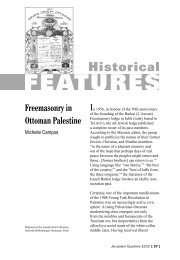
![In Search of Jerusalem Airport [pdf] - Jerusalem Quarterly](https://img.yumpu.com/49007736/1/180x260/in-search-of-jerusalem-airport-pdf-jerusalem-quarterly.jpg?quality=85)
